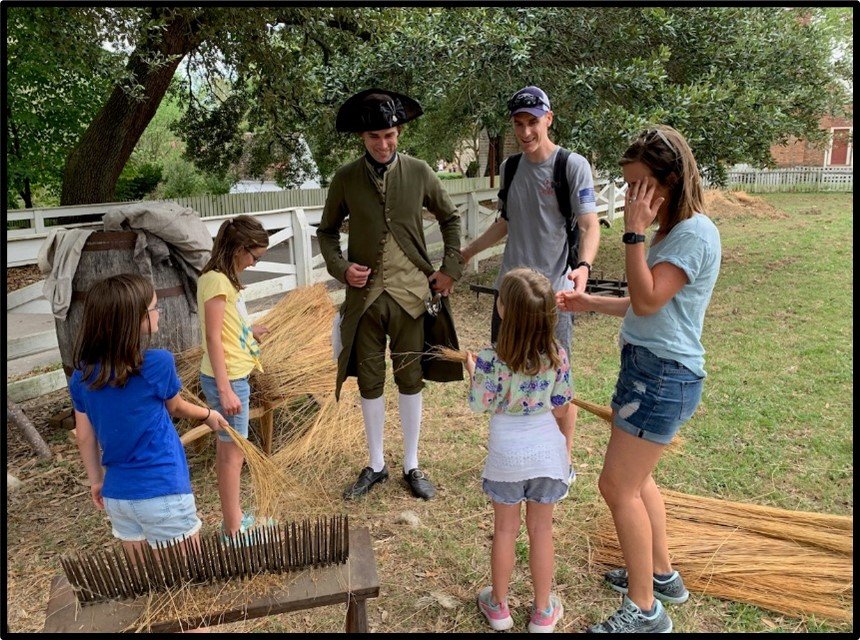My granddaughters explaining flax and linen production to George Washington
Colonial Williamsburg, Virginia
Last week our three granddaughters and their parents had the exciting opportunity to visit Colonial Williamsburg in Virginia. The experience gave them an chance to dine at restaurants that serve from menus that would have been familiar to 18th century America visitors to the colony’s capital and immerse themselves in the sights and sounds of this special place. Several years ago our Palouse Colony Farm supplied Williamsburg’s Great Hope Plantation with the seed of grains like Red May and Virginia White that are known to have been grown in that region during the colonial period, and farmer Ed Schultz kindly hosted our family members for their recent visit. The farm was in the midst of flax harvest so visitors could participate in the kind of “living history” for which Williamsburg is famous, and their time included a memorable conversation with George Washington who surprised them with his extensive knowledge of his extensive Mt. Vernon farming operation.
The girls had great fun splitting the fibrous plants in the first stage of turning flax into linen, and they learned some new vocabulary about the process. Their stories reminded me of interviews I had done years ago with community elders who had grown up on the Volga and knew this very work first-hand. Diminutive, cheery Mary Morasch and Mollie Bafus told of Old Country flax and hemp harvests and the laborious process of transforming the dried stalks into beautiful silvery-brown thread, yarn, and fabric.
These spring-sown crops were pulled out by the roots, tied into small bundles, and first broken down by either dew or soak retting. After drying workers then used a wooden “breaker” to crush the outer, brittle layer for separation with knives from the strands of soft inner bast that extend into the roots. After this peeling process (scutching) the threads were pulled through combs of thin, sharp prongs (hackling) to clean, split, and straighten the fibers. The long, hair-like threads were then spun and woven into three grades of fabric that was patiently boiled and sun-bleached to made into linen tablecloths and bedspreads, heavier work clothes, and coarse material for tents and sacks.
Puget Sound Flax Harvest (c. 1900)
Columbia Heritage Collection
In the 1890s Northwest farmers began experimenting with flax cultivation using plants and techniques introduced from Russia, Belgium, and Holland. Russian Riga and White Blossom Dutch were the most widely cultivated American varieties with vast acreages raised along Puget Sound and in the Willamette Valley. Substantial quantities were exported to Ireland and Scotland. While wistful at memories of life in the Old Country, our immigrant elders we knew did not paint a pastoral idyll. They had willingly left and were grateful to have come to America and Canada.
Volga German speech was heavily seasoned with Russian loanwords, especially in areas like our ancestral village that were located on the periphery of the colonial enclave and closer to ethnic Slavic settlements. Our immigrant elders’ word for granary, ambar, was from a Russian peasant term for barn, ambary, that is probably Persian and came to southern Russia through the region’s Tatar tribes. Like inhabitants of many rural communities, the Volga Germans were very clannish and residents of our people’s village divided it into the Galmucka and Totten sections. These names were derived from the native Buddhist Kalmyk and Muslim Tatar tribes.
Mary Morasch identified two plants used for processing into fabric—Höneft and Fabel, possibly localized Volga German terms for hemp and flax. Dominant Russian flax varieties of the era were Slanets (dew-retted) and Motchenets (water-retted). Lower Volga River production of colorful Sarpinka gingham from cotton was a thriving business originally established in the late 1700s by colonists from Sarepta near the Sarpa River. On Northwest American flax production origins, see A. W. Thornton, European System of Flax Culture Americanized and Adapted to Local Conditions of U. S. A., c. 1917.


